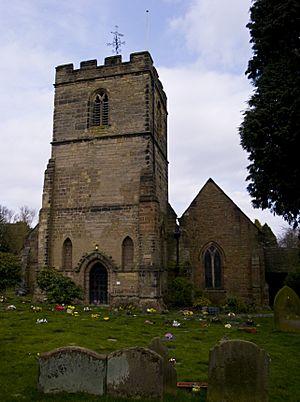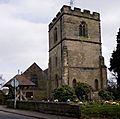St Laurence's Church, Northfield facts for kids
Quick facts for kids St. Laurence's Church, Northfield |
|
|---|---|
 |
|
| 52°24′44″N 1°57′51″W / 52.4121°N 1.9641°W | |
| Denomination | Church of England |
| History | |
| Dedication | St. Laurence |
| Administration | |
| Parish | Northfield, Birmingham |
| Diocese | Birmingham |
| Province | Canterbury |
St. Laurence's Church in Northfield, Birmingham, is a special place of worship for the Church of England. It's located in a historic area, surrounded by old nail maker's cottages, a traditional inn, an old school, and even a Village Pound where stray animals were once kept. This church is not just a building; it's a piece of history!
Contents
A Look Back: The Church's History
This amazing church is a Grade I listed building, which means it's considered a very important historical site. It was first built way back in the 12th century, which is over 800 years ago! You can see some of the best examples of Early English design in the whole area here. There's also a very rare wooden porch from the 14th century outside the south door.
Who Was in Charge?
Long ago, the church and its local area were managed by the Priory of St. James in Dudley. This was a religious house that oversaw many churches.
Changes Over Time
In 1900, a new part called the north aisle was added to the church. This work was done by a famous architect named George Frederick Bodley. If you look closely at the church tower, you might spot a special symbol: a gridiron. This symbol is connected to St. Laurence, the saint the church is named after, who was martyred on a gridiron.
Who Supports the Church?
Keble College, Oxford, a college at the famous Oxford University, actually owns the Advowson for the church. This means they have the right to choose who becomes the main priest, or Rector, for St. Laurence's. You can find a list of all the people who have supported the church and its Rectors, going all the way back to the Domesday Book (a very old survey from 1086), on the church's website.
The Church Bells
St. Laurence's Church has a wonderful set of bells. Originally, there were eight bells, but on November 20, 1999, two more were added, making a total of ten! At the same time, a new room was built at the bottom of the tower specifically for the bell ringers.
The Church Organ
The church has a very special organ that was given by Herbert Austin, 1st Baron Austin and Lady Austin. They donated it in memory of their son, 2nd Lieutenant Vernon James Austin, who sadly passed away in 1915. The organ was built by the Compton Organ Company and was first played on March 22, 1937. It's a large organ with three keyboards and foot pedals, designed to make a wide range of sounds. You can find all the technical details about this organ on the National Pipe Organ Register.
Beautiful Stained Glass Windows
The windows at St. Laurence's Church are truly works of art! Most of them were designed and made by a company called Hardman & Co. They were experts at creating stained glass that looked just like the beautiful designs from the 13th century. Hardman & Co. also made windows for famous places like St. Andrew's Cathedral and St. Mary's Cathedrals in Sydney, Australia, and even for the Houses of Parliament in London, including one in the House of Lords!
Stories in Glass
The windows at St. Laurence's tell many stories from the Bible. Some of the scenes you can see include:
- The Passion of Christ (the story of Jesus's suffering)
- The Resurrection (Jesus coming back to life)
- The Adoration (worshipping Jesus)
- The Nativity (the birth of Jesus)
- The Presentation in the temple before Simeon
- The Annunciation (when Mary was told she would have Jesus)
- The descent of the Holy Spirit upon the Apostles
- Our Lord's appearance to St. Thomas
- The Transfiguration
- Walking on the waters of the Sea of Galilee
- Raising of Lazarus
There are also windows made by other famous artists, Pugin and Kempe.
Ancient Parts of the Church
The church tower and the Chancel (the part of the church where the altar is) are very old, dating back to the 12th or 13th century. Inside, there's a special area called the Lady Chapel in the South Aisle, and another chapel dedicated to St. Laurence in the North Aisle. It's thought that this Norman church might have been built on the same spot where an even older Saxon church once stood, because a priest in "Nordfeld" was mentioned in the Domesday Book of 1086.
War Graves in the Churchyard
The churchyard has an extra section between Kings Norton and Bristol Road. This area contains war graves for sixteen service members. One person buried here died in World War I, and fifteen others died during World War II. These graves remind us of the brave people who served their country.
See also
- Listed buildings in Birmingham
Other Historic Churches in Birmingham




